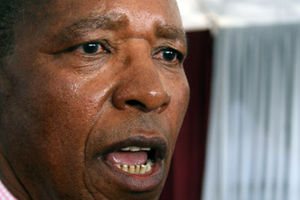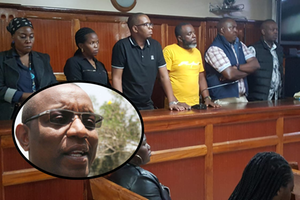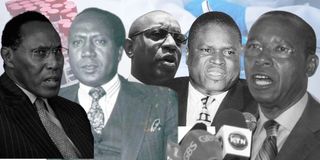
From left: George Saitoti, Robert Ouko, George Thuo, Orwa Ojode and Mutula Kilonzo.
There have been attempts to cover up nearly all high-profile mysterious deaths since Kenya’s independence in 1963 with a tight leash maintained on information flow to ensure the truth is only known by a few people, a book by a retired deputy chief government chemist says
The tell-all account of abductions and disappearances during the reigns of Daniel arap Moi, Mwai Kibaki and Uhuru Kenyatta paints the picture of a code of silence – similar to the mafia omerta — that public servants must submit to for survival.
Autobiography and Revelation of the Mysteries of Life by retired Deputy Chief Government Chemist Wandera Bideru also raises serious integrity, competency and capacity questions of the country’s public service under which falls the various security formations – including the police, intelligence service and directorate of criminal investigations.
On it’s website, the government chemist says it is “the Central Forensic science and analytical testing laboratory with its headquarters in Nairobi” and regional testing centres in Mombasa, Kisumu and Marsabit.
“It is tasked with the provision of forensic science and analytical laboratory services to the criminal justice system, public and environmental health systems,” the website says..
Mr Bideru claims the police, the intelligence service and the executive often excel in the suppression of views they routinely project as a threat to national security and disguise state violence as a tool of choice for retaining power and access to public resources.
He writes that the employment in the public service is blighted by “Patronage, politicisation, ethnicisation and favouritism” that eventually compromises the entire system.
State-engineered abductions
Pointedly, the release of the book coincides with rising public outrage over the phenomena of state-engineered abductions and disappearances that have rocked the country since June 24, 2024, when frustrated youth took to the streets to protest punitive taxation, unemployment and pervasive ethnicity in public service among other governance issues.
While the period covered by Autobiography and Revelation of the Mysteries of Life predates the current state of volatility in Kenya, it nonetheless offers a peek into how the state uses extreme force to marshal loyalty, brooks no opposition and ensures unfettered access to state largesse.
The scientist told the Weekly Review that even where evidence is irrefutable, the affected families are reluctant to pursue criminal justice for fear of reprisals. In the same vein, the police investigators give the evidence a wide berth.
Mr Bideru demonstrates with compelling forensic evidence that the criminal justice system in Kenya is so muffled that some potential witnesses are taken out under the guise of ‘threat to national security’ as in the case of assassinated former Foreign Minister Robert Ouko, in which many would-be witnesses were killed to keep ‘Kenya Inc’ afloat.
After years – in a number of cases, decades – of unanswered questions, Mr Bideru provides rare first-hand insights into how the ‘criminal enterprise’ runs Kenya. Most times, says Mr Bideru, incriminating evidence is swept under the carpet to protect culprits. That was the case with Robert Ouko, former minister for constitutional affairs Mutula Kilonzo, former Juja MP George Thuo, and former vice president George Saitoti, among others.
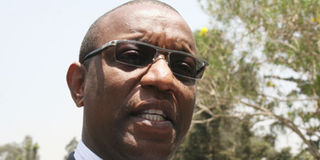
Former Juja MP George Thuo.
He told Weekly Review, “The evidence was always compelling. In the case of George Thuo – for instance – I testified in Milimani Court. I was cross-examined by Dr John Khaminwa and other lawyers. They established that Thuo’s death was an assassination and there were clear pointers to who was behind the murder. The police did not take the cue. What to do with the evidence was out of my power.”
Six people were last year convicted for the murder.
The former government expert said the cover-ups characteristically involve shelving or swapping evidence, creating encumbrances to throw investigators off balance.
The mysterious high-profile deaths remain something that even the police avoid.
“Going public about what they know would jeopardise their (senior police officers) own security, which is why they prefer silence. They know the details of the investigations and findings but they are too scared to go public. They have to look over their shoulders when discussing assassinations,” the scientist explains.
He writes in his book, “I keenly followed the proceedings of the Commission of Inquiry into Dr Robert Ouko’s death set up under the chairmanship of Justice Evan Gicheru. Nothing much connecting this heinous murder was brought to light after months of investigations led by Detective Inspector John Troon, Detective Sgt Lindsay and Pathologist Dr Ian West from Scotland Yard Police in the United Kingdom. A Parliamentary Select Committee set up to inquire into the death of Dr Robert Ouko chaired by Hon Gr Sunguh did not unravel the mystery of the death. I was working in Government Chemist’s Department, Mombasa station. I knew the much sought-after truth concerning the death of Dr Robert Ouko would be made public if the person of Provincial Commissioner (who is not named) …would speak out but his silence reigned for trouble was lurking in the corridors of power.”
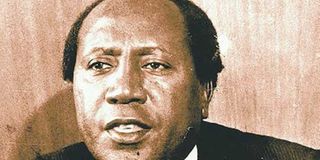
Former Foreign Affairs Minister Robert Ouko. "For if such a loyal and competent defender of the regime could be so brutally killed, no one was safe". PHOTO/FILE
On March 4, 2005, the Daily Nation, quoting the parliamentary select committee chair Gor Sunguh, reported that the orders to eliminate Ouko were given by former president Daniel arap Moi. This was after the committee visited Britain to receive evidence from Troon, who extensively investigated the murder and Swiss business consultant Marianne Briner.
When the author arrived at the scene of crime on February 16, 1990, in the company of police investigators, he says he saw five men who melted away never to be seen again. The identities of the five men sighted when investigators first arrived remain a mystery, but on account of the authors’ memoirs:
“I perceived the presence of five men standing at the spot where the remains of Dr Robert Ouko were lying. Two of the men left together going towards the open savannah in the direction of the Kenya-Tanzania border before separating each going his own way: one proceeded straight ahead and was seen to be going to Tanzanian while a certain (man) went by way of open countryside to the coast where he was provincial commissioner.”
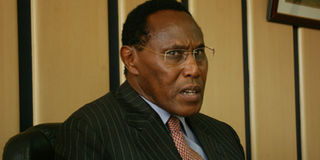
Former Internal Security minister Prof George Saitoti.
In the case of former vice president George Saitoti – who at the time of his death on June 10, 2012, was minister for internal security – and his assistant Joshua Orwa Ojode, the author believes the pilots were not in the right state to fly the helicopter interactions earlier with unnamed people.
It is on record that cabinet ministers, senior officials and other government officials who attended a national security conference chaired by President Kibaki in Mombasa had raised concerns about the discordance in the executive arm of government as political rivalry heightened in the twilight years of the Kibaki administration. Saioti had emerged a frontrunner to inherit the reins of power.
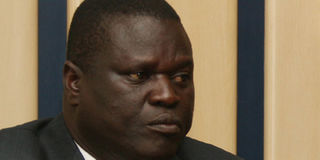
Former Internal Security assistant minister Orwa Ojode.
Against this backdrop, the book infers, Prof Saitoti and Orwa Ojode’s deaths may have been contemplated by government insiders.
“Aware that the Aviation Act does not allow a pilot to seize control of the aircraft if the same consumed alcohol within 8 hours to flying and whose blood alcohol level does not exceed 80milligrams per 100 millilitres, I was keen to find out the levels of alcohol in bloods of the pilot and co-pilot at the time of the helicopter crash. I know from experience of many years in the area of legal chemistry that reliable alcohol level in the body is from either vitreous humour (eyeball fluid) or blood drawn from the femoral vein. It is noteworthy to know that the blood of the deceased pilot and co-pilot submitted for forensic toxicology was drawn from the chest cavities instead of the femoral veins, not even vitreous humour,” he writes.
“(The) pilot’s chest cavity blood carboxyhaemoglobin saturation in the pilot’s blood was high enough to compromise the pilot’s consciousness leading to his inability to take good control of the helicopter,” writes Bideru, who questions how the two pilots were allowed to fly the aircraft in state of heavy intoxication.
He also writes about the death of a prominent politician’s son, in whose body he found a mixture of pesticides.
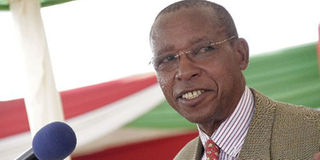
Former Makueni Senator Mutula Kilonzo.
He adds that “the said carbamate group of pesticides was found in the body organs and body fluids of the deceased at lethal concentrations. From the information provided by the police officer investigating the case, the late was taken ill at the place where he went partying yet no evidence was recovered from the place.”
“Personally took charge of every stage of forensic analysis of all case exhibits. I coded wet exhibits and constituted special teams of experienced hands who worked under my direct supervision. DNA profiles were generated from specimens removed from the deceased’s body, vomitus, beverage can and drinking glass for comparative analysis, and to find out if there was a third party at the suspected scene of crime,” he writes.

